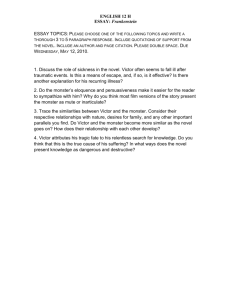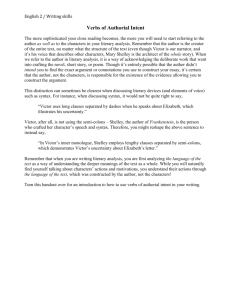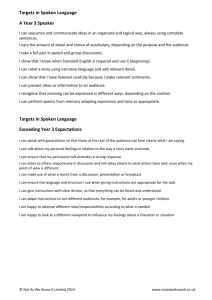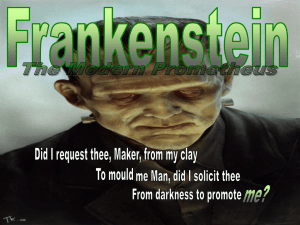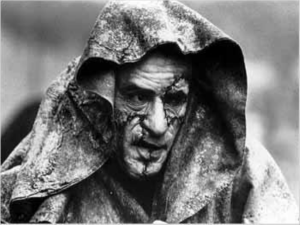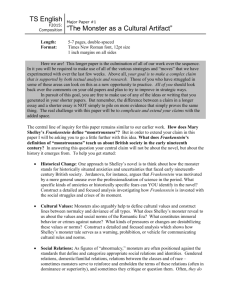Frankenstein Diction Analysis Worksheet
advertisement
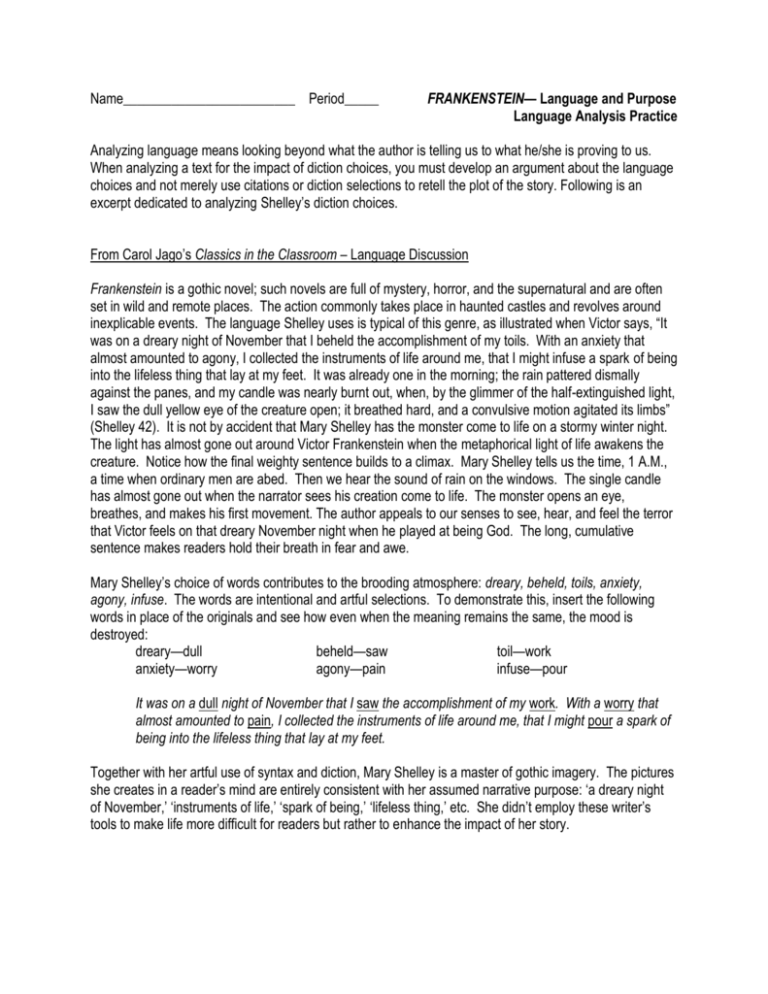
Name_________________________ Period_____ FRANKENSTEIN— Language and Purpose Language Analysis Practice Analyzing language means looking beyond what the author is telling us to what he/she is proving to us. When analyzing a text for the impact of diction choices, you must develop an argument about the language choices and not merely use citations or diction selections to retell the plot of the story. Following is an excerpt dedicated to analyzing Shelley’s diction choices. From Carol Jago’s Classics in the Classroom – Language Discussion Frankenstein is a gothic novel; such novels are full of mystery, horror, and the supernatural and are often set in wild and remote places. The action commonly takes place in haunted castles and revolves around inexplicable events. The language Shelley uses is typical of this genre, as illustrated when Victor says, “It was on a dreary night of November that I beheld the accomplishment of my toils. With an anxiety that almost amounted to agony, I collected the instruments of life around me, that I might infuse a spark of being into the lifeless thing that lay at my feet. It was already one in the morning; the rain pattered dismally against the panes, and my candle was nearly burnt out, when, by the glimmer of the half-extinguished light, I saw the dull yellow eye of the creature open; it breathed hard, and a convulsive motion agitated its limbs” (Shelley 42). It is not by accident that Mary Shelley has the monster come to life on a stormy winter night. The light has almost gone out around Victor Frankenstein when the metaphorical light of life awakens the creature. Notice how the final weighty sentence builds to a climax. Mary Shelley tells us the time, 1 A.M., a time when ordinary men are abed. Then we hear the sound of rain on the windows. The single candle has almost gone out when the narrator sees his creation come to life. The monster opens an eye, breathes, and makes his first movement. The author appeals to our senses to see, hear, and feel the terror that Victor feels on that dreary November night when he played at being God. The long, cumulative sentence makes readers hold their breath in fear and awe. Mary Shelley’s choice of words contributes to the brooding atmosphere: dreary, beheld, toils, anxiety, agony, infuse. The words are intentional and artful selections. To demonstrate this, insert the following words in place of the originals and see how even when the meaning remains the same, the mood is destroyed: dreary—dull beheld—saw toil—work anxiety—worry agony—pain infuse—pour It was on a dull night of November that I saw the accomplishment of my work. With a worry that almost amounted to pain, I collected the instruments of life around me, that I might pour a spark of being into the lifeless thing that lay at my feet. Together with her artful use of syntax and diction, Mary Shelley is a master of gothic imagery. The pictures she creates in a reader’s mind are entirely consistent with her assumed narrative purpose: ‘a dreary night of November,’ ‘instruments of life,’ ‘spark of being,’ ‘lifeless thing,’ etc. She didn’t employ these writer’s tools to make life more difficult for readers but rather to enhance the impact of her story. Assignment Diction is the choice of a particular word as opposed to others. A writer could call a rock formation by many words – a stone, a boulder, an outcropping, a pile of rocks, a cairn, a mound, or even an "irregular geological feature." The analytical reader then faces tough questions. Why does the author use this particular choice of words? What is the effect of the specific diction? The word choice a writer makes determines the reader's reaction to the object of description and contributes to the author's style and tone. Choose one 1-5 sentence passage from the novel and examine the diction. In a short paragraph that fully integrates citations, describe how the author’s choices impact the mood, setting, or characterization in the novel. Make sure to make explicit connections; pull specific words from the passage and argue their purpose and effect! Use class format, and if possible, please type your response. Due _______________________ Example Diction Language Analysis Paragraph As with most ghost stories, Mary Shelley uses specific diction choices regarding light to repeatedly shift the mood when Victor succeeds in animating the monster. The mood is revealed as the light evolves through the scene. First, the light is quite dim as displayed in the word “dreary” (42). At this point, the creature has not taken its first breath; therefore, not much light exists. The drab mood is easily established because the monster’s life is as dreary and dull as the light that filters into the bleak room. Once the scientific work is completed, though, Shelley uses the word “spark” (42) to demonstrate the final step of Frankenstein’s experiment as he brings his creation to life. This diction changes the mood to Note the statement of purpose (thesis) Note how the writer has dissected the language choices and analyzed each word individually, not just provided a summary or discussion of a longer citation one of hope. A spark is a quick burst, an illumination against darkness; thus Frankenstein’s efforts will ignite the being’s body and bring it to life and out of the darkness it inhabits. The last diction choices that reveal the mood surrounding the creator and creation, however, is the exchange of light. Victor’s “candle was nearly burnt out” as “the dull yellow eye” opened Tie the word choices to the targeted literary element (42). One light must be extinguished in order for the next to burn brightly. Just as the monster is brought into the light of life, the actual light around Victor dims, plunging him into both a literal and figurative darkness, a darkness that haunts Victor throughout the rest of the novel. This dimming eradicates the hopefulness seen earlier in the passage and leaves the reader feeling as overwhelmed and despondent as Victor, showcasing the fearful mood. In conclusion, Shelley brings the monster – and the mood of the novel – to life through the use of light. Note the conclusion reinforces the writer’s purpose Example Diction Language Analysis Paragraph with Step 3 Theme Added As with most ghost stories, Mary Shelley uses specific diction choices regarding light to repeatedly shift the mood when Victor succeeds in animating the monster in order to prove that the fear of the unknown causes man to retreat from others. Victor’s fear is mood is revealed as the light evolves through the creation scene. First, the First this light is quite dim as displayed in the word “dreary” (42). At this point, the creature has not taken its first breath and the outcome of Victor’s experiment is unknown; therefore, not much light exists. The drab mood is also easily established because the monster’s nonexistent life is as dreary and dull as the light that filters into the bleak room. However, once the scientific work is completed, though, Shelley uses the word “spark” (42) to demonstrate the final step of Frankenstein’s experiment as he brings his creation to life and engage with it. This diction changes the mood to one of hope. A spark is a quick burst, an illumination against darkness; thus Frankenstein’s efforts will ignite the being’s body and bring it to life and out of the darkness it inhabits. The reader is now hopeful of Victor’s humanity as it is expected that he will engage with his actual creation. But fear inevitably takes over when Victor realizes what he has created is beyond what he can comprehend. Therefore the mood disintegrates as seen in these last diction choices that reveal the mood surrounding the creator and creation’s newfound relationship or lack thereof. however, is the exchange of light. Victor’s “candle [is] nearly burnt out” as “the dull yellow eye” opens (42). One light must be extinguished in order for the next to burn brightly. Just as the monster is brought into the light of life, the actual light around Victor dims, plunging him into both a literal and figurative darkness, a darkness that haunts Victor throughout the rest of the novel. This dimming light represents Victor’s choice to withdraw from his creation out of his fear for what he has just created. This fear then eradicates the hopefulness seen earlier in the passage and leaves the reader feeling as overwhelmed and despondent as Victor, showcasing the fearful mood. In conclusion, Shelley brings the monster – and the mood of the novel – to life through the use of light. Shelly demonstrates how man’s fear of the unknown causes him to withdraw through her use of light which creates the fluctuating moods.

